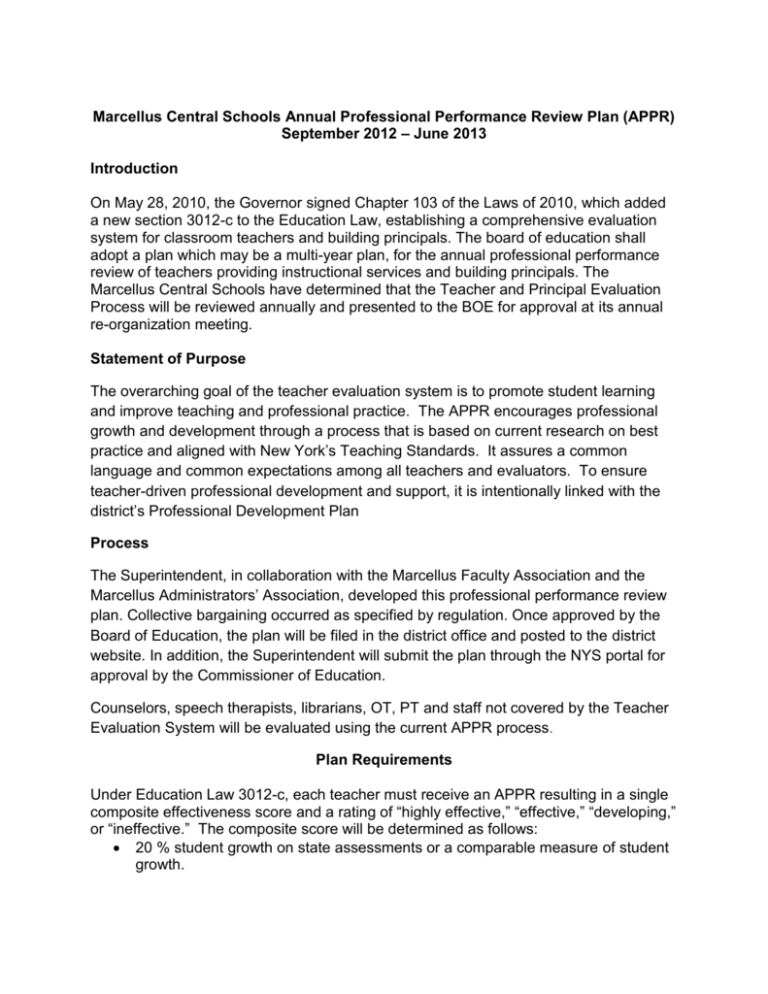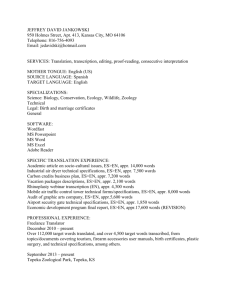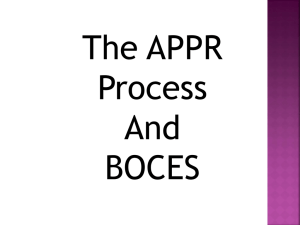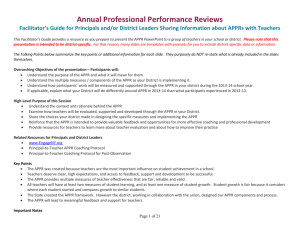Marcellus Central School District APPR Plan
advertisement

Marcellus Central Schools Annual Professional Performance Review Plan (APPR) September 2012 – June 2013 Introduction On May 28, 2010, the Governor signed Chapter 103 of the Laws of 2010, which added a new section 3012-c to the Education Law, establishing a comprehensive evaluation system for classroom teachers and building principals. The board of education shall adopt a plan which may be a multi-year plan, for the annual professional performance review of teachers providing instructional services and building principals. The Marcellus Central Schools have determined that the Teacher and Principal Evaluation Process will be reviewed annually and presented to the BOE for approval at its annual re-organization meeting. Statement of Purpose The overarching goal of the teacher evaluation system is to promote student learning and improve teaching and professional practice. The APPR encourages professional growth and development through a process that is based on current research on best practice and aligned with New York’s Teaching Standards. It assures a common language and common expectations among all teachers and evaluators. To ensure teacher-driven professional development and support, it is intentionally linked with the district’s Professional Development Plan Process The Superintendent, in collaboration with the Marcellus Faculty Association and the Marcellus Administrators’ Association, developed this professional performance review plan. Collective bargaining occurred as specified by regulation. Once approved by the Board of Education, the plan will be filed in the district office and posted to the district website. In addition, the Superintendent will submit the plan through the NYS portal for approval by the Commissioner of Education. Counselors, speech therapists, librarians, OT, PT and staff not covered by the Teacher Evaluation System will be evaluated using the current APPR process. Plan Requirements Under Education Law 3012-c, each teacher must receive an APPR resulting in a single composite effectiveness score and a rating of “highly effective,” “effective,” “developing,” or “ineffective.” The composite score will be determined as follows: 20 % student growth on state assessments or a comparable measure of student growth. 20% other locally selected measures of student achievement that are determined to be rigorous and comparable across classrooms which are to be developed locally through collective bargaining. 60% based on multiple measures of effective teaching practice aligned with the state’s teaching standards. These measures are to be established locally through collective bargaining. The intent of the evaluation system is to foster a culture of continuous growth for professionals. The APPR is required to be a significant factor in employment decisions including, but not limited to: retention, tenure determination, termination, supplemental compensation and professional development. Each decision is made in accordance with locally developed procedures that have been collectively bargained. Should the APPR Plan be rejected by the Commissioner of the State Education for any deficiencies, each such deficiency shall be resolved through collective bargaining and when concluded, the APPR Plan will be re-submitted. The District and the Marcellus Faculty Association, through a joint labor-management committee known as the APPR Committee, will meet at least annually for the purpose of reviewing guidelines, procedures, measurements, targets, point allocations, and assessments related to the APPR. This meeting will take place as soon as practical, but not later than March 1 of each school year. Student Growth Measures State-provided Measure of Student Growth For classroom teachers of grades 4-8 ELA and Math, state assessments will be used for the growth component. Teachers of subjects where there is no state-provided measure of student growth on state assessments (i.e. subjects without a state assessment and subjects where a state provided growth measure has not yet been created based on the state assessment) must use other comparable measures of growth. These teachers will have a growth measure based on methodology prescribed by SED. Student Learning Objectives (SLO) SLOs, by definition, require an understanding of local needs and objectives. Because of this, SLOs will need to be developed collaboratively between administrators and an individual teacher or groups of teachers. For subject courses that do not end in a state assessment, the district will provide time for the development of assessments by individuals or teams of teachers. A form has been included in the Appendix to help members develop individual SLOs. It is anticipated that SED will score and report the state-provided growth measure (or value-added measure after the VAM system is approved by the Board of Regents) no later than September 1st, following the year the teacher is evaluated. Teachers will not be penalized in any way because of such data not being received in a timely manner, which results in an incomplete rating. Locally Selected Measure of Student Achievement The locally selected measure of student achievement shall be determined annually by a committee of teachers and administrators. For the 2012-13 school year, the APPR committee has determined that the district measure of student achievement will reflect mastery rates on the 5 required Regents for graduation. The APPR Committee will review the components of the Locally Selected Measure of Student Achievement annually and determine if Marcellus will continue to use a district assessment to measure students’ achievement or change to a committee of each grade level and subject area. The APPR committee will annually review the locally selected measures of student achievement to ensure their continued validity, reliability and appropriateness. The selection of other local measures of student achievement shall be the exclusive responsibility of the APPR committee. The Superintendent shall, to the extent practical, provide all APPR committee members with time during the contractual work day to meet. Multiple Measures of Effectiveness The teacher evaluation process & criteria will be based upon the 60% multiple measures aligned with the NYS Teaching Standards. New York Teaching Standards Knowledge of Students and Student Learning: Teachers acquire knowledge of each student, and demonstrate knowledge of student development and learning to promote achievement for all students. Knowledge of Content and Instructional Planning: Teachers know the content they are responsible for teaching, and plan instruction that ensures growth and achievement for all students. Instructional Practice: Teachers implement instruction that engages and challenges all students to meet or exceed the learning standards. Learning Environment: Teachers work with all students to create a dynamic learning environment that supports achievement and growth. Assessment for Student Learning: Teachers use multiple measures to assess and document student growth, evaluate instructional effectiveness, and modify instruction. This includes assessment techniques based on appropriate learning standards designed to measure students' progress in learning and that he or she successfully utilizes analysis of available student performance data (for example: State test results, student work, school-developed assessments, teacher-developed assessments, etc.) and other relevant information (for example: documented health or nutrition needs, or other student characteristics affecting learning) when providing instruction. Professional Responsibilities and Collaboration: Teachers demonstrate professional responsibility and engage relevant stakeholders to maximize student growth, development, and learning. This includes the development of effective collaborative relationships with students, parents or caregivers, as needed and appropriate support personnel to meet the learning needs of students. Professional Growth: Teachers set informed goals and strive for continuous professional growth. Process for Multiple Measures of Effectiveness The remaining 60% (or 60 out of the total 100 point composite score) of the composite effectiveness score is based on other measures of teacher effectiveness consistent with standards prescribed by the Commissioner in regulation. The New York State Teaching Standards rubric will be used to evaluate classroom teachers. That rubric is included in the appendix. In order to support continuous professional growth, 60 points shall be based on observations of teacher and submission of a portfolio binder that demonstrates competency in the NYS Teaching Standards. Deadline for choosing the observation option is October 1, 2012. Once a decision is made you are not allowed to change it. One observation will be announced, with a pre-conference before the observation and a post conference within 5 school days. Tenured teachers will have the choice of one announced and one unannounced full period observation or one announced full period observation and 3 unannounced mini observations (15-20 min). Each observation will be followed within 5 school days with a post conference meeting. Non Tenured teachers will have two announced full period observations and 3 unannounced mini observations (15-20 min). Each observation will be followed by a post conference within 5 school days. Unannounced mini observations will result in the evaluator leaving a card that indicates possible dates for the teacher to select from for the post conference. The teacher will return a copy of the card to the evaluator. It is the responsibility for both parties to schedule the post conference within 5 school days. Teachers will have 5 school days following the post conference to provide supporting evidence on the NYS standards relating to the observation. Teachers will be able to provide supporting evidence of competency in the standards on an ongoing basis to support those standards that are not readily observed within the classroom observation up to May 31, 2013. Evidence should include but not be limited to student work, videos, lesson plans, conversations, or student outcomes. The first observation (tenured) or the first two observations (non-tenured) must be completed by December 15, 2012. The remaining observations or mini observations must be completed by April 1, 2013. Teachers and lead evaluators will have a mid-year review to discuss evidence collected to date by January 31, 2013. Teachers who select the 1:1 observations will schedule a March meeting that may be cancelled if the teacher chooses. All other teachers have the option of requesting a second review by March 31, 2013 to review their evidence of competency. A joint email from the administration and MFA will be sent out by February 16th reminding teachers of this option... Evidence collected through observations will focus on standards 3, 4 and the first element of standard 5. Supporting documentation for standards 1, 2, the remainder of 5, 6 and 7 will be provided by the teacher. All evidence points will be documented and will be accessible throughout the year by the teacher through a web based process. Teachers and lead evaluators will have a summative meeting to review the 60% measure between May 1-24, 2013. The teacher may submit additional evidence in support of his/her competencies up to 5 days after his/her summative conference. Teachers will earn points as follows: Administrators will allocate 31 points based upon evidence observed in the observation and post conference discussions: 17 points for Standard 3, 12 points for Standard 4 and 2 points for Standard 5, indicator 1. Teachers will allocate 29 points based upon evidence provided during postconferences or throughout the year as listed above: 6 points for standard 1, 6 points for standard 2, 8 points for standard 5, 5 points for standard 6 and 4 points for standard 7. Subcomponent and Composite Scoring Ranges The State Education Department has set the following scoring ranges for the overall rating categories, the rating categories for the State assessment and other comparable measures subcomponent, and the locally selected measures subcomponent. Level Student Growth on State Assessments or Other Comparable Measures Locally Selected Measures of Student Achievement 60% Other Measures Ineffective Results are wellbelow State Results are wellbelow district or Overall performance and average for similar students (or district goals if no State test). BOCES-adopted expectations for growth or achievement of student learning standards for grade/subject. results are well below standards. Developing Results are below State average for similar students (or district goals if no State test). Results are below district or BOCESadopted expectations for growth or achievement of student learning standards for grade/subject. Overall performance and results need improvement in order to meet standards Effective Results meet State average for similar students (or district goals if no State test). Results meet district or BOCESadopted expectations for growth or achievement of student learning standards for grade/subject. Overall performance and results meet standards. Highly Effective Results are wellabove State average for similar students (or district goals if no State test). Results are well above district or BOCES-adopted expectations for growth or achievement of student learning standards for grade/subject. Overall performance and results exceed standards. Subcomponent and Composite Scoring Ranges Level Ineffective Developing Effective Highly Effective Student Growth on State Assessments or Student Learning Objective Locally Selected Measures of Student Achievement: Graduation rate Other 60 Points Overall Composite Score 0-2 3-8 9-17 18-20 0-2 3-8 9-17 18-20 0-49 50-56 57-58 59-60 0-64 65-74 75-90 91-100 The State Education Department is responsible for determining the subcomponent scoring ranges for student growth on state assessments or other comparable measures and the locally selected measures of student achievement. It is also responsible for determining the overall composite score. The subcomponent scoring ranges in the above chart for the other 60 points have been developed locally. Summative Evaluation meeting The summative evaluation includes the teacher’s annual rating of effectiveness and the rationale supporting the rating. Both, areas of strength and areas in need of improvement, should be identified as specific recommendations made to improve effectiveness. The summative evaluation will include all of the evidence of effective teaching practice and the measures of student achievement. Composite Score Rating System The rating system will be developed and evaluated annually by the APPR committee. On the first day of school for teachers, or no later than October 1, 2012 teachers will be informed of the rating procedures and made aware of what is required for teacher to be rated “highly effective,” “effective,” “developing,” or “ineffective” for the 20% locallyselected measure and the 60% other measure of teacher effectiveness. The stateprovided 20% growth measure, or comparable measure subcomponent, shall be formulated by the state. Notification of Score The entire APPR must be completed and provided to each teacher as soon as practicable, but in no case later than the first day for school of the year next following the school year for which the teacher performance is being measured. The teacher's rating and score on the 60% other measures of teacher effectiveness shall be computed and provided to the teacher, in writing, no later than the last day of school in which the teacher is being evaluated. The 20% locally-selected measure based on mastery rate for the 5 required Regents for Graduation will be notified of their score within 10 school days of the district receiving the Regents data. Teachers, who utilize SLO for their growth scores, will be notified of their score by the last day of school if a regional or district assessment was used to determine growth, or within 10 business days of the district receiving the state assessment scores used to evaluate growth on their SLO. This timeline may be adjusted to accommodate delays at the State level. The purpose of this notification is to provide teachers sufficient time to assess their practices and plan accordingly, including seeking professional development and other supports through the summer. Collection and Reporting of Teacher and Student Data Working with the Central New York Regional Information Center, the district will provide all of the data elements described by SED. Data will be submitted to the SED through the portal each year. Growth Measure The District shall ensure that the State Education Department receives accurate teacher and student data, including enrollment and attendance data, and any other student, teacher, school, course, and teacher/student linkage data necessary to comply with the Regulations of the Board of Regents by providing such data in a format and timeline prescribed by the Commissioner. The process shall also provide an opportunity for every classroom teacher and building principal to verify the subjects and or student rosters assigned to them prior to using student growth and or achievement data in an APPR. Any classroom teacher who believes that the list is incorrect and or inconsistent with the standards established by the Commissioner’s regulations for making teacher of record determinations shall be entitled to see a review of this determination through an appeal to the 3 member APPR Appeal Committee. Data Verification Beginning of school year: Teachers will be given an initial roster no later than the last day of the third week of school for initial review and will be required to sign off on the final verification the day before BEDS day. Throughout the school year teachers will be able to go into the SED website to verify the student-teacher data on their roster. Teachers will notify the data warehouse coordinator of any discrepancies in writing and will receive written response to the outcome of their concern. Teachers will be able to appeal any issues or concerns to the 3 person APPR Appeal Committee. Teachers will be notified of any changes made by the State Education Department as soon as possible. The district will notify teachers of all student verification procedures and timelines. Reporting to SED The district will follow all Regulations and requirements for reporting sub-component and composite scores to the NYSED. A unique identification number will be used and the names of individual teachers will not be provided. Upon request of a parent or legal guardian, the District shall disclose the final quality rating and composite effectiveness score for each of the teachers the student is assigned to, after verifying the parent or guardian is entitled to review and receive the information. Except as provided above for parents or legal guardians, the APPRs of individual teachers shall not be subject to discloser pursuant to the Freedom of Information Law. No public release of APPR information by the district shall include any personally identifying information for a teacher. The clause is subject to modification based upon any regulation or reporting requirement to allow the district to comply with all current laws and requirements for disclosure. Evaluator and Staff Training The superintendent will ensure that all evaluators have been trained and that all lead evaluators have been trained and certified in accordance with regulation. The district will utilize BOCES Network Team evaluator training and lead evaluator training and certification in accordance with SED procedures and processes. Lead evaluator training will include training on: 1) The New York State Teaching Standards, and their related elements and performance indicators and the Leadership Standards and their related functions, as applicable; 2) Evidence-based observation techniques that are grounded in research; 3) Application and use of the student growth percentile model and the value-added growth model; 4) Application and use of the teacher or principal rubric(s), including training on the effective application of such rubrics to observe a teacher or principal's practice; 5) Application and use of any assessment tools that the school district or BOCES utilizes to evaluate its classroom teachers or building principals, including but not limited to, Structured portfolio reviews; student, parent. Teacher and/or community surveys; professional growth goals and school improvement goals, etc. 6) Application and use of any locally selected measures of student achievement used by the district evaluate its teachers or principals; 7) Use of the Statewide Instructional Reporting System; 8) The scoring methodology including how scores are generated for each subcomponent and the composite effectiveness score and application and use of the scoring ranges prescribed by the Commissioner for the four designated rating categories used for the teacher's or principal's overall rating and their subcomponent ratings; and 9) Specific considerations in evaluating teachers and principals of English language learners and students with disabilities. The superintendent will ensure that lead evaluators participate in annual training and are re-certified on an annual basis. The BOCES Network Team will be utilized to provide the training and recertification. Any evaluation or APPR rating that is determined in part or whole by an administrator who is not fully trained and certified by the end of the school year in which the APPR rating was completed shall upon appeal by the subject of the evaluation or APPR rating, be deemed to be invalid and shall be expunged from the teacher’s record and will be inadmissible as evidence in any subsequent disciplinary proceeding. The invalidation of a lead evaluator for an evaluation or APPR rating for this reason shall also preclude its use in any and all other employment decisions. Staff Training All professional staff subject to the district’s APPR will be provided with an orientation and or training on the evaluation system that will include a review of the content and the use of the evaluation system, a review of the NYS Teaching Standards, a review of the NYSUT Rubric, forms and procedures to be followed consistent with the approved APPR plan, and associated contractual provisions prior to the implementation of the APPR process. All new staff will be trained at the District’s New Teacher Orientation program or within seven business days of starting work. Professional Development The District Professional Development Committee shall be responsible for developing all aspects of the professional development plan as it relates to the needs of teachers for implementation of the APPR. This plan is reviewed and updated on a regular basis and is the foundation of all professional development related to APPR. Teacher Improvement Plans If a teacher’s performance is evaluated as “ineffective” or “developing”, the supervisor shall be required to develop a Teacher Improvement Plan in consultation with the staff member. The MFA President will be notified if a teacher is placed on a Teacher Improvement Plan and will be given a copy of the plan. Such Plan will be provided to the staff member and implemented within ten days of the start of the school year within which the Plan will be applied. The Plan shall include, but not be limited to, an identification of the areas in need of improvement, a timeline for achieving improvement, suggestions for improvement, support to be provided, and measurable outcomes to be evaluated. Costs associated with the recommended improvements will be provided by the district at no cost to the teacher. The plan will describe the professional learning activities that the teacher must complete. These activities will be connected to the areas needing improvement. The artifacts that the teacher must produce that could serve as benchmarks for improvement and as evidence for the successful completion of their improvement plan will be described and could include such items as lessons, student work, or unit plans for a teacher and for a principal. The plan will include the additional support and assistance that will be provided to the teacher. The teacher and administrator will meet according to the schedule identified in the TIP to assess the effectiveness and appropriateness of the TIP for the purpose of assisting the teacher to achieve the goals set forth in the TIP. No disciplinary action predicated upon ineffective performance will be taken against the teacher until the TIP has been fully implemented and its effectiveness in improving the teacher’s performance has been evaluated. Upon completion of the teacher improvement plan, the supervisor will meet with the teacher to review the plan, including artifacts and evidence, in order to provide a final, summative rating for the staff member. Successful attainment of TIP goals will result in termination of the TIP, communication on the successful completion to the teacher in writing, and reflection in the summative evaluation of the teacher. Evidence collected during the teacher evaluation observations will not be used for purposes of Article 11 in the current collective bargaining agreement. Appeals The following procedure is the exclusive means for initiating, reviewing, and resolving any and all challenges and appeals related to a teacher’s or principal’s performance review, and/or improvement plan. A teacher who receives an effectiveness composite score rating of “ineffective” or “developing” may appeal his or her performance review. Ratings of “highly effective” or “effective” cannot be appealed. A teacher may appeal only the school district’s adherence to standards and methodologies required for such reviews, adherence to applicable regulations of the commissioner of education, and compliance with the procedures for the conduct of performance reviews set forth in the annual professional performance review plan. A teacher may not file multiple appeals regarding the same performance review. All grounds for appealing a particular performance review must be raised within the same appeal. Any grounds not raised at the time the appeal is filed shall be deemed waived. Appeals concerning a teacher’s performance review must be filed no later than fifteen (15) calendar days of the date when the teacher receives it. A teacher wishing to initiate an appeal must submit, in writing, to the Superintendent a detailed description of the precise point(s) of disagreement over his or her performance review, along with any and all additional documents or written materials that he or she believes are relevant to the resolution of the appeal. Any such additional information not submitted at the time the appeal is filed shall not be considered in the deliberations related to the resolution of the appeal. Under this appeals process the teacher bears the burden of proving by substantial evidence the merits of his or her appeal. The decision will be rendered by a three person review panel for an appeal concerning a teacher’s performance review. The superintendent, working with the Marcellus Faculty Association President, will appoint the panel comprised of the superintendent, one district lead evaluator who has not participated in the evaluation process for that teacher, and one MFA executive board member (teacher). The panel shall issue a written decision on the merits of the appeal no later than thirty (30) calendar days from the date when the teacher filed his or her appeal. The decision of the panel shall be final and an appeal shall be deemed completed upon the issuance of that decision. The decision of the panel shall not be subject to any further appeal. Appeals related to the issuance of an improvement plan are limited to issues regarding compliance with the requirements prescribed in applicable law and regulations for the issuance of improvement plans, and must be initiated within fifteen (15) calendar days of the alleged failure of the District to comply with such requirements. Termination and Tenure Determinations for Probationary Teachers The APPR is to be a significant factor for termination and tenure determination. If a teacher is at risk of not receiving tenure or being dismissed based upon the APPR process, the district will follow the current negotiated timeline and requirements for notification and decision-making as stipulated in the collective bargaining agreement.








